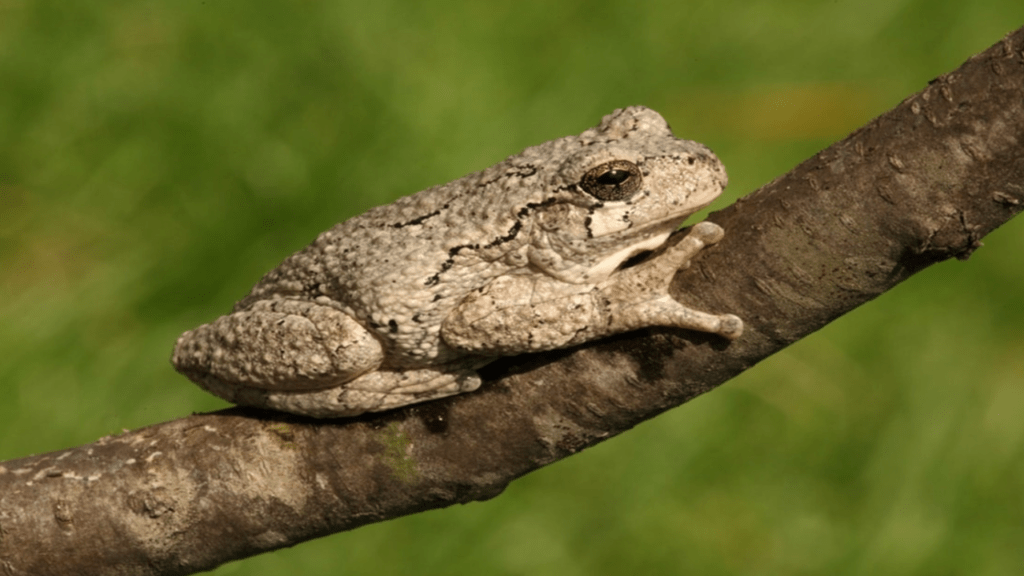
Grey Tree Frog Care Essentials: Keep Your Frog Healthy and Happy
Grey tree frogs are popular pets for amphibian enthusiasts, but they do require specific care to keep them healthy and happy. In this article, we will cover everything you need to know about caring for a grey tree frog, including their habitat, diet, and overall health and well-being. By following these guidelines, you can ensure that your pet frog thrives in its environment.
Table of Contents
ToggleSetting up the proper habitat for your grey tree frog
Grey tree frogs, with their amazing climbing abilities and color-changing camouflage, can make fascinating and rewarding amphibian companions. But before welcoming one of these lively creatures into your home, you need to create a comfortable and healthy habitat that caters to their specific needs. Here’s a guide to setting up the perfect grey tree frog terrarium:
The Terrarium Itself:
- Size Matters: Adult grey tree frogs are arboreal (meaning they love to climb), so provide a vertically oriented glass terrarium with a minimum size of 30 gallons (113 liters) for a single frog. This allows them ample space to explore and climb.
- The Great Escape: Escape-proof ventilation is crucial. Look for terrariums with mesh tops that allow for proper air circulation while preventing your adventurous frog from becoming a Houdini.
Furnishing the Froggy Abode:
- Climbing Paradise: Replicate a treetop environment with a variety of branches, vines, and driftwood of varying thicknesses. Position them horizontally, diagonally, and vertically to create a climbing labyrinth for your frog.
- Leafy Luxury: Live plants not only add beauty to the terrarium but also help maintain humidity levels. Opt for non-toxic, frog-friendly plants like pothos, bromeliads, or philodendrons. Artificial plants can also be used, but ensure they are smooth and have no sharp edges that could injure your frog.
- Taking a Dip: Provide a shallow water dish large enough for your frog to comfortably soak its entire body. A shallow dish minimizes the risk of drowning.
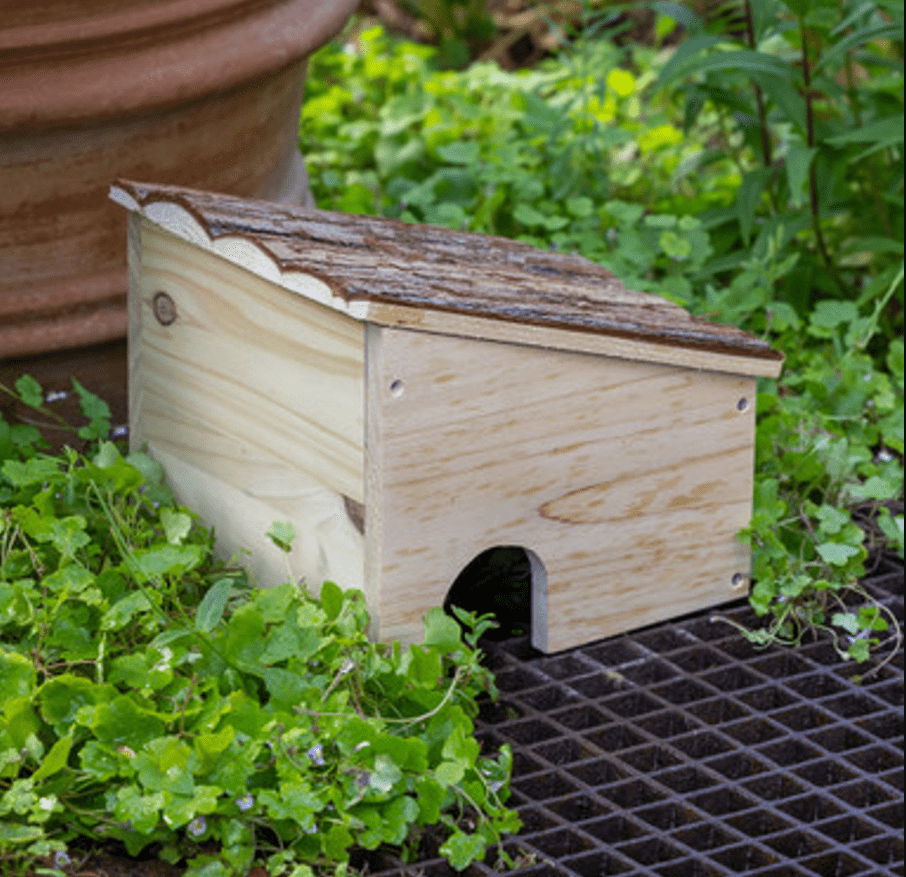
Flooring the Froggy Palace:
- Substrate Selection: Line the bottom of the terrarium with a moisture-retentive substrate that facilitates easy cleaning. Here are some good options:
- Reptile Bark: Provides good drainage and is easy to clean.
- Coconut Fiber: Excellent at retaining moisture and creates a more naturalistic environment.
- Sphagnum Moss: Holds moisture exceptionally well but requires more frequent cleaning to prevent mold growth.
Important Note: Avoid using soil or gravel, as these can be harmful if ingested by your frog.
Creating the Perfect Climate:
- Tropical Temperatures: Grey tree frogs are cold-blooded and thrive in warm environments. Maintain a temperature gradient within the terrarium, with a basking area reaching 75-80°F (24-27°C) and a cooler area around 70°F (21°C) at night. Use a heat lamp or heat mat regulated by a thermostat to achieve this.
- Lighting Up Their Lives: Provide UVB lighting with a low UVB rating (around 5.0 UVB) for 8-12 hours a day. This helps with vitamin D3 synthesis, crucial for bone health and overall well-being. Turn it off at night to simulate a natural day/night cycle.
- Humidity Haven: Grey tree frogs require high humidity levels between 60-80%. Achieve this by:
- Misting the terrarium with chlorine-free or distilled water daily.
- Utilizing a cool mist humidifier to maintain consistent humidity levels.
- Including live plants, which naturally help regulate humidity.
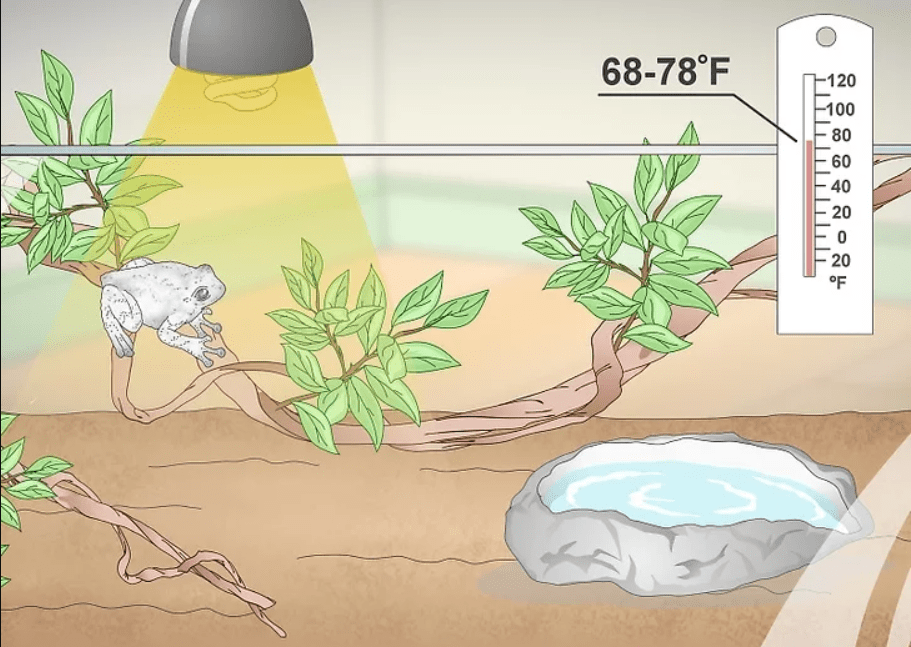
Additional Considerations:
- Hiding Spots: While grey tree frogs are primarily arboreal, providing hiding spots like cork bark rounds or hollow logs gives them a sense of security.
- Double the Dishes: Keep two water dishes – one for soaking and another for drinking. This helps maintain water quality.
- Feeding Station: Include a small, shallow dish for feeding your frog.
Providing the right diet and nutrition for your frog
Grey tree frogs are fascinating insectivores, meaning they thrive on a diet of live insects. But simply grabbing a handful of crickets from the pet store isn’t enough. To ensure your amphibian friend gets the right nutrients and stays healthy, you need to provide a balanced and varied diet. Here’s a guide to proper nutrition for your grey tree frog:
Menu Planning for Your Mini Monster:
- Variety is Key: Offer a diverse selection of feeder insects to your frog. This not only keeps them interested but also ensures they receive a wider range of nutrients. Some suitable options include:
- Crickets: A staple food, but avoid overfeeding them as they can be low in certain nutrients.
- Mealworms: A good source of protein and fat, but feed sparingly as they’re high in chitin, which can be difficult to digest.
- Phoenix Worms: Nutrient-rich and easy to digest, making them a great staple feeder.
- Fruit Flies: Perfect for smaller grey tree frogs.
- Waxworms: Treat these as an occasional snack due to their high-fat content.
Portion Control:
- Size Matters: The size of the feeder insect should generally be no larger than the width of your frog’s mouth. Offering prey items that are too large can be choking hazards.
- Froggy Feasts: Feed adult grey tree frogs 2-3 times a week, offering enough insects they can consume in 15 minutes to prevent overfeeding. Younger frogs might need to be fed more often.
Supercharge Their Meals:
- Gut Loading Power: To maximize the nutritional value of feeder insects, practice gut loading. 24-48 hours before feeding, gut load your insects with a commercially available gut-loading formula or nutritious fruits and vegetables rich in vitamins and minerals. This ensures your frog gets the essential nutrients it needs from its meals.
Vitamin and Mineral Boost:
- Dusting for Success: Lightly dust feeder insects with a calcium and vitamin D3 supplement a few times a week. This helps prevent nutritional deficiencies and promotes healthy bones and growth. Shake off any excess powder before feeding.
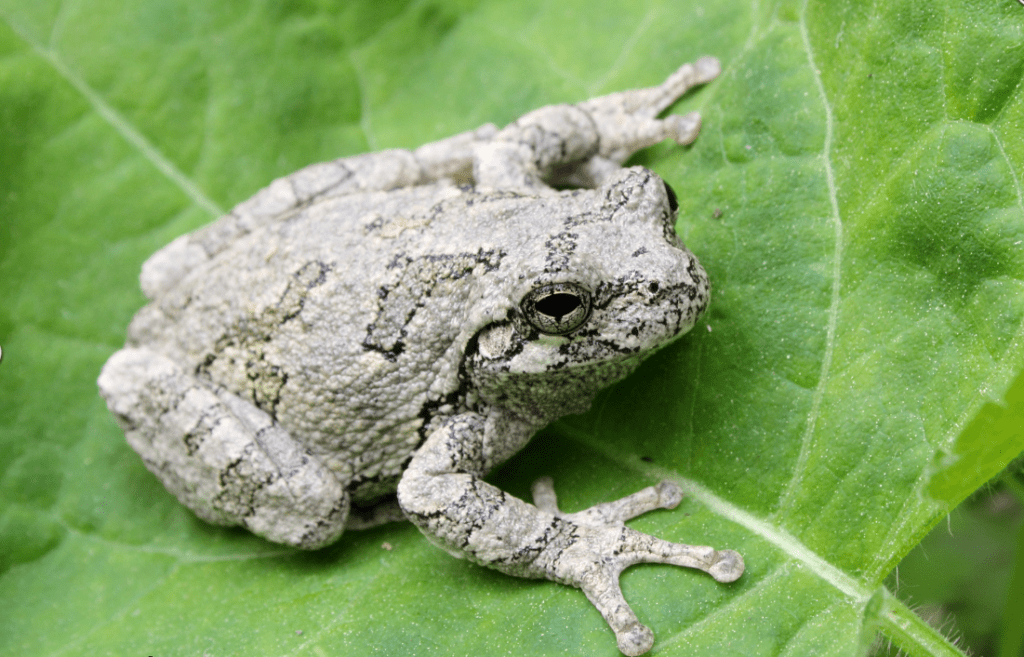
Hygiene Habits:
- Cleanliness is Key: Remove uneaten insects after 24 hours to prevent them from escaping or harming your frog. They can also decompose and contaminate the terrarium.
- Dish Duty: Clean the feeding dish regularly with hot water to prevent bacteria growth.
Important Note:
- Avoid Wild-Caught Insects: Wild-caught insects can carry parasites or diseases harmful to your frog. Stick to feeder insects from reputable pet stores.
Ensuring the health and well-being of your pet frog
Grey tree frogs, with their vibrant colors and acrobatic climbing skills, can make captivating amphibian companions. But like any pet, they require specific care to flourish in captivity. Here’s a comprehensive guide to maintaining the health and well-being of your grey tree frog:
Creating the Perfect Habitat:
- The Terrarium Setup: Provide a vertically oriented glass terrarium with a minimum size of 30 gallons (113 liters) for an adult frog. Equip it with escape-proof mesh ventilation, climbing branches, live or artificial plants, and a shallow water dish (see “Setting up the proper habitat for your grey tree frog” for a detailed breakdown).
- Mimicking the Tropics: Maintain a warm temperature gradient within the terrarium (70-80°F or 21-27°C) with a basking area and a cooler zone. Utilize a UVB light with low UVB rating and a heat lamp or heat mat regulated by a thermostat. Ensure proper humidity levels (60-80%) through misting and a humidifier (see “Setting up the proper habitat for your grey tree frog” for details).
Dietary Do’s and Don’ts:
- Feeding Frenzy: Offer a varied diet of gut-loaded feeder insects like crickets, mealworms, phoenix worms, and fruit flies, sized appropriately for your frog (no larger than its mouth). Feed adults 2-3 times a week, and young frogs more frequently. Remove uneaten insects after 24 hours and clean the feeding dish regularly.
- Nutritional Boost: Dust feeder insects with a calcium and vitamin D3 supplement a few times a week to prevent deficiencies. Avoid wild-caught insects due to potential parasites. (See “Providing the right diet and nutrition for your frog” for more information).
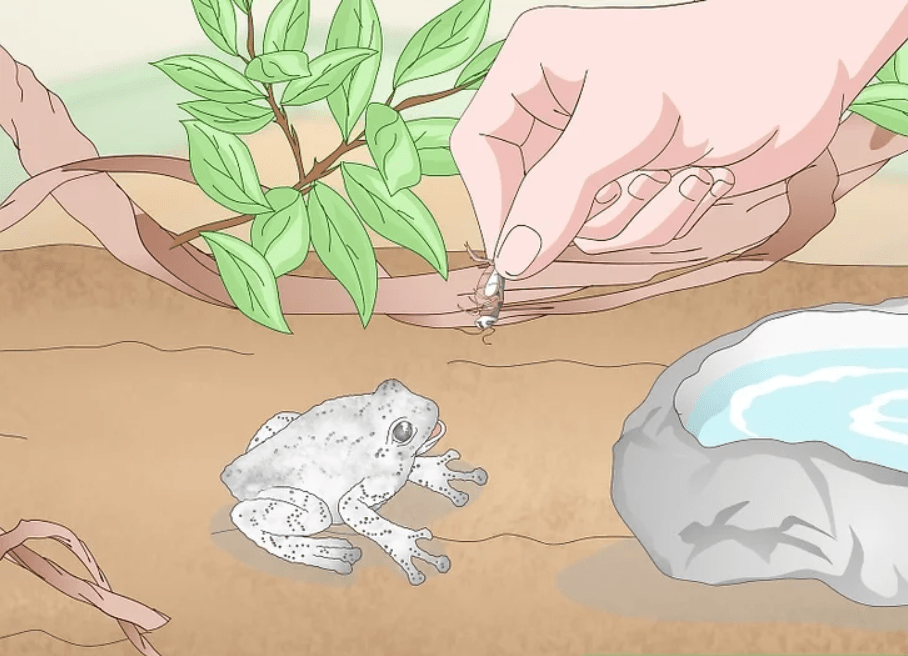
Cleaning and Maintenance:
- Spot cleaning is essential: Regularly remove feces and uneaten food to maintain hygiene.
- Deep Clean Routine: Perform a complete terrarium cleaning every month. Dispose of old substrate, disinfect the enclosure with a reptile-safe disinfectant, and replace the water dish. Always wear gloves during cleaning.
Veterinary Care:
- Schedule regular checkups: Schedule annual checkups with a veterinarian experienced in exotic pets to ensure your frog’s health.
Handling with Care:
- Minimize handling: Grey tree frogs can be easily stressed. Handle them only when necessary, using wet hands to avoid removing their protective mucus layer.
Signs of a Happy and Healthy Frog:
- A good appetite: Your frog should readily eat the offered feeder insects.
- Clear, bright eyes: Cloudy or bulging eyes can indicate health problems.
- Smooth and moist skin: Dry, flaky skin can be a sign of dehydration or improper environment.
- Active behavior: A healthy frog will climb, explore, and react to stimuli in its environment.
Additional Tips:
- Peaceful Cohabitation: Grey tree frogs are solitary creatures. House only one frog per terrarium to prevent territorial aggression.
- Monitor Water Quality: Regularly test the water quality in the terrarium’s water dish and change it if it becomes cloudy or dirty.
- Do your research: Stay updated on grey tree frog care best practices by consulting reputable sources and talking to experienced frog owners or veterinarians.
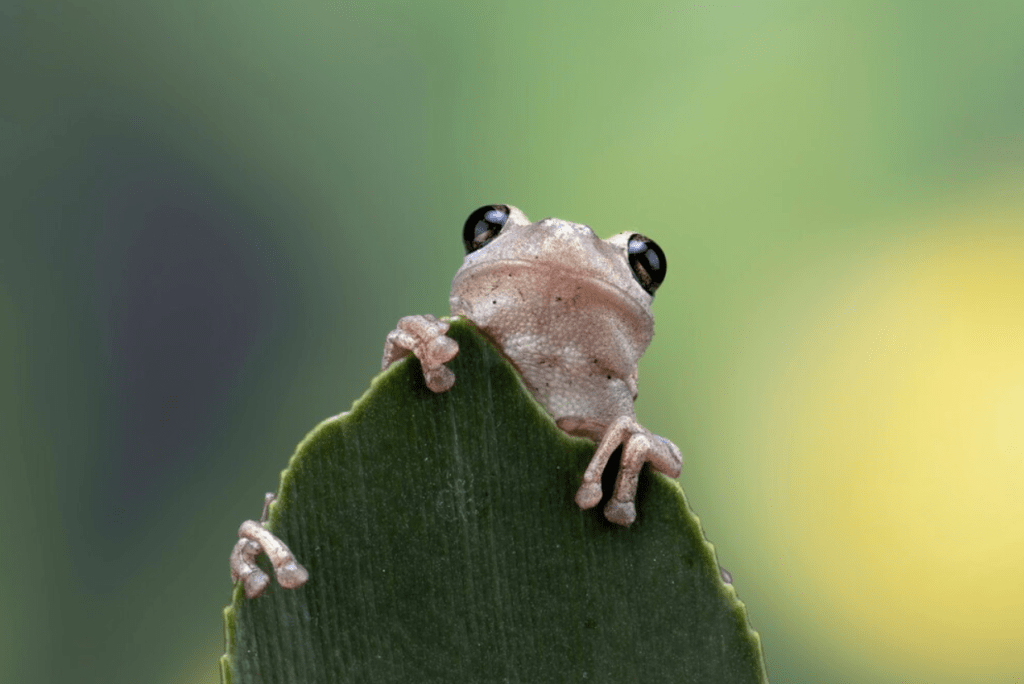
Handling and interacting with your grey tree frog
Grey tree frogs are captivating creatures, but they’re also wildlife at heart and can stress easily. While handling isn’t essential for a happy and healthy frog, there may be times when it’s necessary, such as during tank cleaning or a vet visit. Here’s how to minimize stress and ensure safe interaction with your grey tree frog:
Less is More:
- Minimize Handling: Grey tree frogs are best observed and admired from afar. Handle them only when absolutely necessary, and for very brief periods. Frequent handling can be a stressful experience for them.
Gentle Approach:
- Wet Hands are Happy Hands: Before handling your frog, dampen your hands slightly with clean, chlorine-free water. This prevents you from removing their protective mucus layer, which can make them susceptible to infection.
- Support is Key: Cup your hands gently but securely around the frog’s body, never grabbing by the legs or delicate limbs. Ensure their entire body is well-supported.
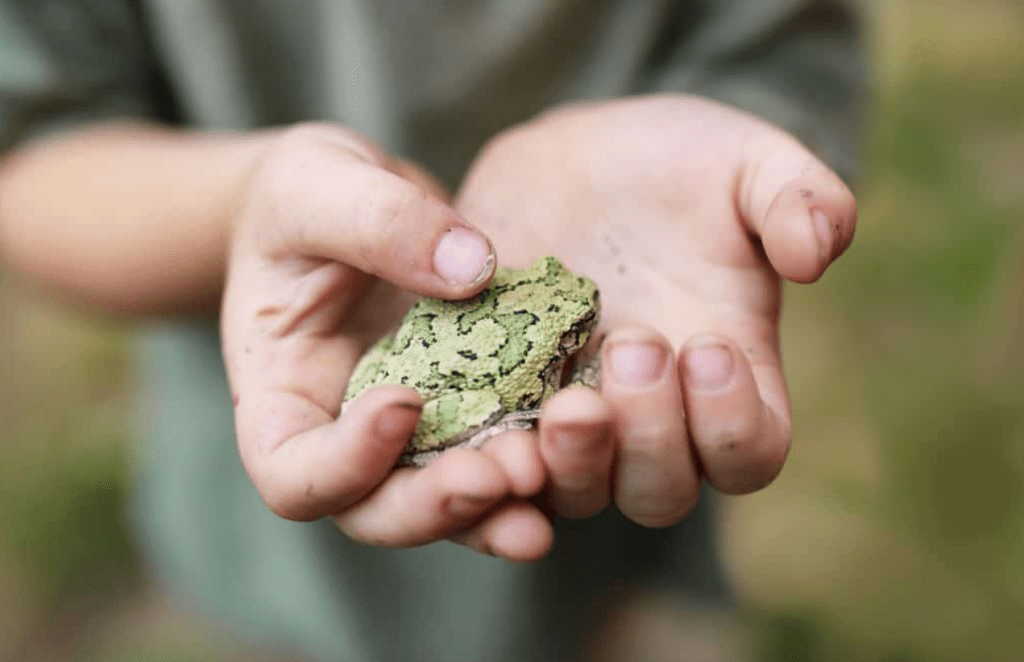
A Swift Transfer:
- Quick and Calm: The handling process should be swift and stress-free. Move your frog directly from its terrarium to its temporary holding container (a well-ventilated critter carrier lined with damp paper towels) and back again as quickly as possible.
Respect Their Space:
- Don’t Force Interaction: Grey tree frogs are not cuddly creatures. Don’t attempt to hold them for extended periods or force them into unnatural positions. Let them perch on your hand if they choose to, but allow them to jump back to their enclosure when they seem ready.
Alternative Interactions:
- Observation is Key: Provide enrichment for your frog by offering live plants with hiding spots to explore, and watch them climb and hunt feeder insects. This is a much less stressful way to interact with your amphibian friend.
- Target Training (Optional): With patience and positive reinforcement, you can slowly train your frog to associate your presence with something positive, like food. This can be helpful during tank cleaning or vet checkups. Use a target stick to gently guide them towards a feeder insect, rewarding them with the treat when they approach.
Signs of Stress:
- Be Aware: Watch for signs of stress in your frog, such as puffed-up throat, closed eyes, or bright orange coloration (usually seen on their legs). If you see these signs, immediately return your frog to its terrarium and minimize further handling.
Safety First:
- Wash Your Hands: Always wash your hands thoroughly with soap and water after handling your frog and its terrarium to prevent the spread of germs.
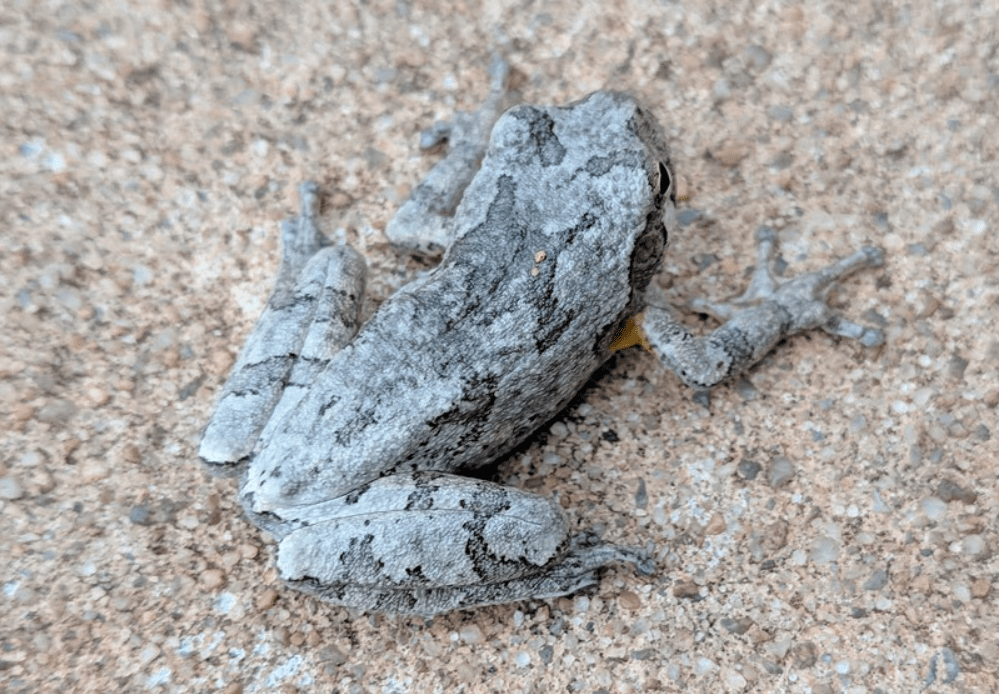
Common health issues and how to address them
Grey tree frogs are generally hardy creatures, but like any pet, they can be susceptible to certain health issues in captivity. Early detection and intervention are key to ensuring your frog’s well-being. Here’s a breakdown of some common health problems faced by grey tree frogs, along with tips for addressing them:
Nutritional Deficiencies:
- Symptoms: Listlessness, poor appetite, weight loss, deformed bones.
- Causes: Inadequate diet lacking in essential vitamins and minerals, improper gut-loading of feeder insects, or a lack of calcium and vitamin D3 supplementation.
- Prevention: Provide a varied diet of gut-loaded feeder insects, dust them with a calcium and vitamin D3 supplement a few times a week, and ensure proper UV lighting in the terrarium.
Dehydration:
- Symptoms: Dry, flaky skin, sunken eyes, lethargy.
- Causes: Insufficient humidity levels in the terrarium, not providing a clean water source, or your frog not recognizing the water dish.
- Prevention: Maintain proper humidity levels (60-80%) through misting and a humidifier. Offer a shallow water dish large enough for soaking and keep it clean. Some frogs may drink from droplets on leaves, so ensure adequate moisture on terrarium plants.
Skin Problems:
- Symptoms: Reddened skin, bumps, ulcers, or excessive shedding.
- Causes: Bacterial or fungal infections, improper substrate (like soil or gravel), low humidity, or chemical burns from cleaning products.
- Prevention: Maintain proper hygiene by spot cleaning regularly and performing complete terrarium cleanings with reptile-safe disinfectants. Use a moisture-retentive substrate like reptile bark or coconut fiber. Ensure proper humidity levels. If you suspect an infection, consult a veterinarian experienced in exotic pets.
Temperature Imbalance:
- Symptoms: Lethargy, loss of appetite, difficulty breathing, abnormal skin color.
- Causes: Temperatures exceeding safe ranges (too hot or too cold) or improper basking area setup.
- Prevention: Use a thermometer and thermostat to regulate the temperature gradient within the terrarium. Ensure the basking area reaches 75-80°F (24-27°C) with a cooler area around 70°F (21°C) at night.
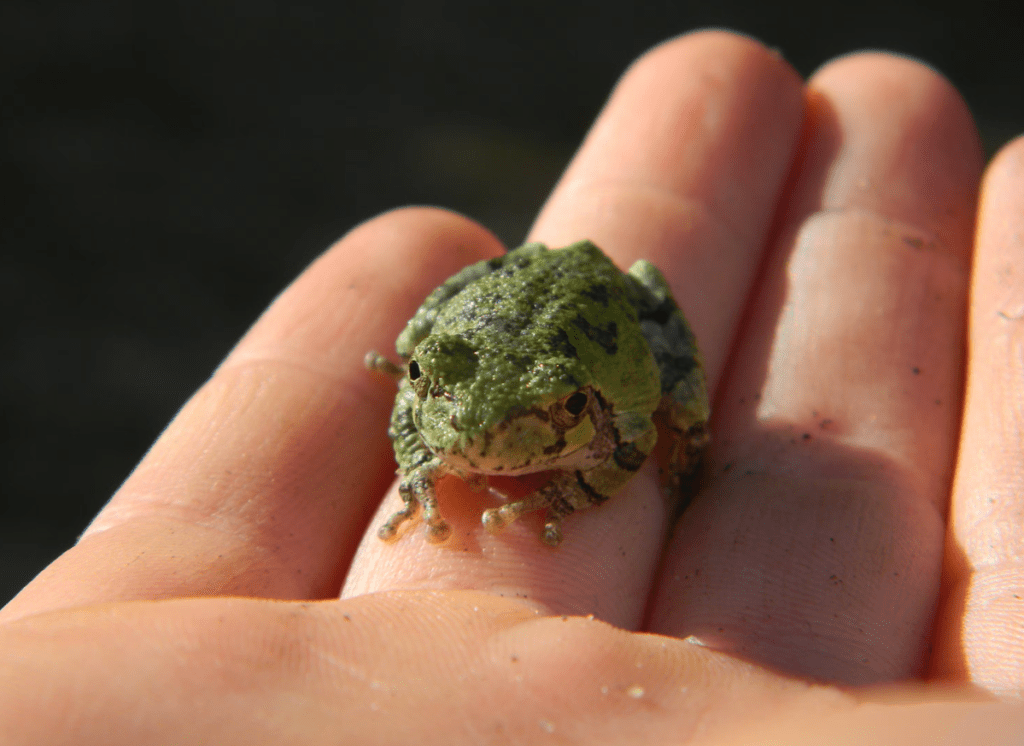
Parasites:
- Symptoms: Weight loss, lethargy, bloating, diarrhea.
- Causes: Internal or external parasites contracted from feeder insects or contaminated environments.
- Prevention: Purchase feeder insects from reputable sources and avoid wild-caught ones. Quarantine new frogs before introducing them to your existing terrarium. If you suspect parasites, seek a veterinarian’s advice for accurate diagnosis and appropriate treatment.
Impaction:
- Symptoms: Constipation, lethargy, loss of appetite, vomiting (frogs regurgitate).
- Causes: Ingesting inappropriate objects like substrate or feeder insects that are too large.
- Prevention: Provide feeder insects of an appropriate size and avoid using loose substrate like gravel. If you suspect impaction, consult a veterinarian immediately.
Remember: Early detection is crucial for successful treatment. Schedule regular checkups with a veterinarian experienced in exotic pets to ensure your frog’s health. By recognizing the signs of these common health concerns and taking preventative measures, you can help your grey tree frog live a long and healthy life.
Tips for creating a happy and healthy environment for your pet frog
Here are some tips for creating a happy and healthy environment for your pet grey tree frog:
Habitat Haven:
- The Right Abode: Provide a vertically oriented glass terrarium with a minimum of 30 gallons (113 liters) for an adult frog. Escape-proof mesh ventilation is essential.
- Climbing Paradise: Furnish the terrarium with branches, vines, and driftwood of varying thicknesses for climbing. Include live or artificial plants for hiding spots and humidity.
- Flooring Matters: Line the bottom with a moisture-retentive, frog-safe substrate like reptile bark or coconut fiber. Avoid using soil or gravel, as these can be harmful if ingested.
- Watery Oasis: Provide a shallow water dish large enough for your frog to soak comfortably. Keep it clean and consider adding a second dish for drinking.
Thriving Temperatures:
- Tropical Feels: Maintain a warm temperature gradient within the terrarium. Aim for a basking area of 75-80°F (24-27°C) and a cooler area around 70°F (21°C) at night. Use a heat lamp or heat mat with a thermostat for regulation.
Lighting Up Their Lives:
- Essential UVB: Provide low-UVB lighting (around 5.0 UVB) for 8-12 hours a day for vitamin D3 synthesis and bone health. Turn it off at night to simulate a natural day/night cycle.
Humidity Highway:
- Moisture Magic: Grey tree frogs require high humidity levels (60-80%). Achieve this by:
- Misting the terrarium with chlorine-free or distilled water daily.
- Using a cool mist humidifier to maintain consistent humidity.
- Including live plants, which naturally help regulate humidity.
Dietary Delights:
- Varied Feast: Offer a diverse diet of gut-loaded feeder insects like crickets, mealworms, phoenix worms, and appropriately sized flies. Feed adults 2-3 times a week, and young frogs more frequently. Remove uneaten insects after 24 hours.
- Nutritional Boost: Dust feeder insects with a calcium and vitamin D3 supplement a few times a week to prevent deficiencies.
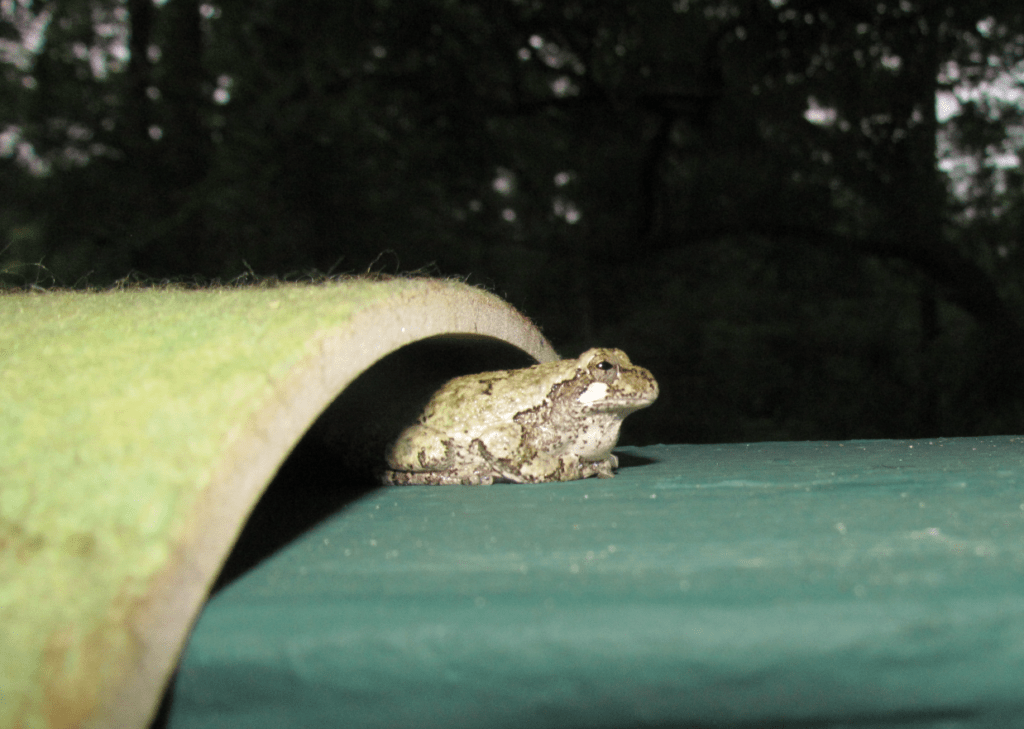
Cleanliness Counts:
- Spot clean the terrarium regularly to remove waste and uneaten food.
- Perform a complete cleaning Dispose of old substrate, disinfect the enclosure with a reptile-safe disinfectant, and replace the water dish. Always wear gloves during cleaning.
Peaceful Coexistence:
- Grey tree frogs are solitary. House only one frog per terrarium to prevent territorial aggression.
Minimizing Handling:
- Handle your frog only when necessary, using wet hands for support. Less is more when it comes to handling to minimize stress.
Regular Checkups:
- Schedule annual checkups with a veterinarian experienced in exotic pets to ensure your frog’s health.
Bonus Tips:
- Observe Your Frog: Be familiar with your frog’s normal behavior and appearance. Early detection of any changes can help identify potential health issues.
- Research and Learn: Stay updated on grey tree frog care best practices by consulting reputable sources and talking to experienced frog owners or veterinarians.
By following these tips and creating a comfortable, stimulating, and healthy environment, you can ensure your pet grey tree frog thrives in your care. Remember, a happy and healthy frog is a curious and active frog, bringing joy to your home!
Frequently Asked Questions(FAQ)
Grey tree frogs thrive in tall terrariums with plenty of vertical space for climbing. Ensure the enclosure has proper ventilation, humidity, and temperature control.
Maintain temperatures between 70-75°F during the day and slightly cooler temperatures at night. Use a combination of ambient room temperature and a heat lamp to achieve the desired temperature gradient.
Maintain humidity levels between 60-80% by misting the enclosure regularly and providing a shallow water dish for soaking. Monitor humidity levels with a hygrometer and adjust as needed.
Grey tree frogs are insectivores and should be fed a varied diet of live insects such as crickets, fruit flies, and mealworms. Dust insects with a calcium supplement powder before feeding.
Adult grey tree frogs should be fed every 2-3 days, while juveniles may require more frequent feedings. Monitor your frog’s appetite and adjust feeding frequency accordingly.
Grey tree frogs can tolerate gentle handling but should be handled sparingly to minimize stress. Always wash your hands before and after handling to prevent the spread of bacteria.
Watch for signs of illness such as lethargy, loss of appetite, abnormal skin coloration, or difficulty breathing. Seek veterinary care promptly if you notice any concerning symptoms.
Grey tree frogs are generally solitary animals and may become territorial if housed together. It’s best to keep them individually or in compatible pairs with ample space and hiding spots.
Incorporate live plants, climbing branches, and other decor items into the enclosure to create a dynamic and engaging environment. Rotate decor periodically to prevent boredom and encourage natural behaviors.
